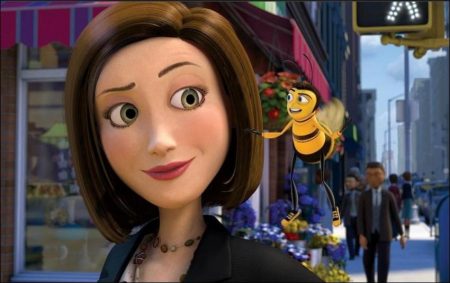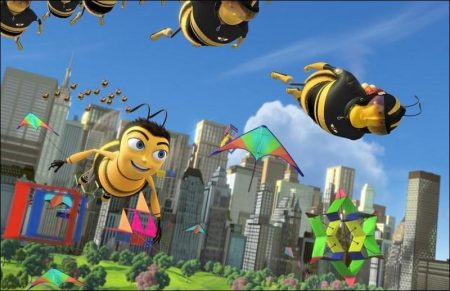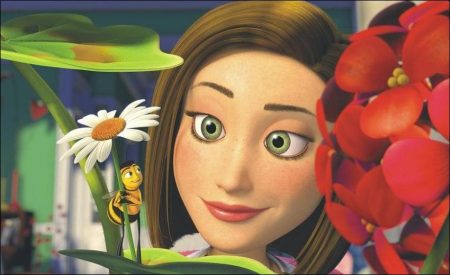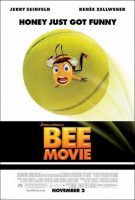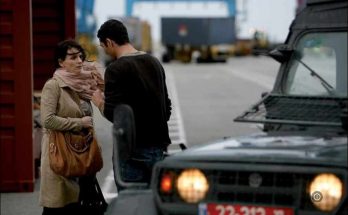Tagline: Honey just got funny.
Bee Movie is a comedy that will change everything you think you know about bees. Having just graduated from college, a bee by the name of Barry B. Benson (Jerry Seinfeld) finds himself disillusioned with the prospect of having only one career choice – honey. As he ventures outside of the hive for the first time, he breaks one of the cardinal rules of the bee world and talks to a human, a New York City florist named Vanessa (Renée Zellweger). He is shocked to discover that the humans have been stealing and eating the bees’ honey for centuries, and ultimately realizes that his true calling in life is to set the world right by suing the human race for stealing their precious honey.
Bee Movie is a 2007 American computer animated comedy film produced by DreamWorks Animation and distributed by Paramount Pictures. Directed by Simon J. Smith and Steve Hickner, the film stars Jerry Seinfeld and Renée Zellweger, with Matthew Broderick, Patrick Warburton, John Goodman and Chris Rock in supporting roles. Its story follows Barry B. Benson (Seinfeld), a honey bee who sues the human race for exploiting bees after learning from his florist friend Vanessa (Zellweger) that humans sell and consume honey.
The film opened in second place to American Gangster, but its gross of $38,021,044 had it more in line with the studios’ lowest-grossing features, such as Shark Tale. The film had an average of $9,679 from 3,928 theaters. In its second weekend, the film held well with a 33% drop to $25,565,462 and claiming the top spot, resulting in a $6,482 average from expanding to 3,944 theaters.
Its widest release was 3,984 theaters, and closed on February 14, 2008 after 104 days of release, grossing $126,631,277 domestically along with an additional $160,963,300 overseas for a worldwide total of $287,594,577. Based on its box office performance, the film failed to recoup its production budget of $150 million. Following the income from home media and pay television, the film ultimately turned a small profit for the studio.
The Real People Behind the Bees
It has taken four years to make “Bee Movie” and one million man hours to animate it, with an estimated 25 million render hours used during the course of the production…that’s five times more than the original “Shrek.” Now THAT’S a lot of BEES! It is no exaggeration to say that the animation team created upwards of one million bees for “Bee Movie,” specifically in the sequence where the bees help to land the jet. Around 750,000 bees carry the plane, and about 350,000 bees form the flower pattern on the ground. In the five or so shots where these groups are together, more than 1,000,000 million bees are onscreen.
Jeffrey Katzenberg had been trying to convince Jerry Seinfeld for more than 12 years to be in an animated film, but Seinfeld wasn’t really interested in acting in a movie – even an animated one. Then one night over dinner with his Hamptons neighbor, filmmaker Steven Spielberg, a break in the conversation resulted in Seinfeld announcing that he had an idea for an animated film called “BEE Movie”
Steven loved the idea and the title and immediately phoned Katzenberg after dinner telling him to get a hold of Seinfeld ASAP. The deal was done before Jerry even knew it, and the four-year journey of making “BEE Movie” had begun.
Jerry Seinfeld has always been fascinated with bees: their shape, color, the fact that they create something as amazing as honey (they are only bugs after all). He wondered how bees would react if they knew that humans were taking and selling their invaluable product…and that’s where the idea for “Bee Movie”’s storyline came from.
Welcome to the sandbox: Jerry Seinfeld was not overly familiar with the animation process, so Jeffrey Katzenberg gave him a crash course-Making Animated Movies 101-and mentored him through production. Seinfeld later described the process to being given a sandbox and told that you could shape and mold its contents into absolutely anything…with one catch: you’re given one grain of sand at a time and it would take four years to make it!
Jerry, Meet Barry; Barry, Jerry. The writer / producer / lead actor feels that he is Barry B. Benson-curious, strives to know everything, is uninterested in the nine-to-five life, shares a strikingly similar sense of humor. Seinfeld’s friends are quick to point out that his bee alter-ego is more naïve and less experienced than Jerry.
Jerry Seinfeld is known for always wearing tennis shoes, hence Barry’s choice of footwear. In early stages of design, Barry looked like Jerry Seinfeld as a bee dressed in a sweater, but all felt the design wasn’t quite right…so filmmakers took Barry in a slightly different direction, as in rounder and sillier-looking. That proved to be the ticket. However, it took between 800 and 900 designs before the final Barry was found.
How to catch a florist-A longtime fan of Renée Zellweger, Seinfeld immediately thought of her for the role of Vanessa. Since the two had never met, Jeffrey Katzenberg conveniently sat them next to each other at the 2004 New York premiere of Shark Tale in Central Park, where the idea was pitched and enthusiastically received.
Renée Zellweger would show up extremely prepared for her recording sessions with pages of questions for Jerry-everything from motivations to factual questions-which she would have answered before recording her tracks.
No offense to the plastic guy…The role of Ken, voiced by Patrick Warburton, was so named in reference to a certain one-foot-tall plastic guy-both are handsome, slightly stiff, without a lot going on upstairs. Seinfeld penned the role with Patrick Warburton in mind, and both had such a great time during recording sessions that engineers began booking long periods in the studio just to tape a few lines of dialogue…a lot of time was spent with Seinfeld laughing uncontrollably, much to Warburton’s amusement.
As Jerry Seinfeld and Matthew Broderick are close friends, Broderick was first choice to voice Barry’s best friend, Adam. Seinfeld felt that their off-screen friendship would flesh out the bees’ relationship, and that Broderick’s dry and subtle delivery was perfect for Adam.
Chris Rock and Jerry Seinfeld ad-libbed most of their dialogue together. Chris’ character of Mooseblood the mosquito was originally scripted with only a few lines…but once the in-studio magic began, the cameo became a role with more than 50 lines. Mooseblood’s diatribe about female mosquitoes wanting to “date up” is the brainchild of Rock and Seinfeld.
Megan Mullally was originally cast as the queen bee, a character which was developed for the film over a two year period; however, when the part was cut due to story changes, Seinfeld was so impressed with Megan’s delivery that he created the part of Trudy, the Honex tour guide, to keep her involved in the project.
Jerry Seinfeld visited a French bee keeper in Long Island early in production. The keeper did not believe in wearing protective outfits and ensured Jerry that there wouldn’t be any problems. With everything off to a great start, the bee keeper began showing off somewhat, deciding to show the queen bee to Jerry. Quicker than you can say, “Swarm!,” the bees began to come after Jerry, with one determined attack bee stalking Seinfeld, eventually stinging him on the nose. (The fact that the angry bee would perish from the act-bees die after they sting-did not make Jerry feel any better!)
Seinfeld’s commitment and vision was evident at every turn; he was present at every single recording session (attending a record 135 separate days of recording!), voicing Barry’s lines opposite the other actors in the scene (a luxury that rarely happens during the making of animated films). The upshot-with the film’s writer / producer / lead at every session, new material was invariably produced on the spot and a great deal ended up in the final film.
The Pollen Jocks are voiced by stand-up comedians and friends of Jerry’s-including Tom Papa and Mario Joyner.
Director Simon J. Smith is a talented voice artist himself, and he recorded many “scratch” (or early temporary) voices, several of which ended up in the final film: the bee who provides Barry with a waiver to sign before taking off with the Pollen Jocks; and the truck driver who clears his windshield of Barry, Mooseblood and others with wipers and fluid.
Dave Pimentel, the head of the story department, also provides the voice of Hector, the box boy.
Don’t get stung-Producer Christina Steinberg is allergic to bees in real life.
Ray Liotta ran into Jerry Seinfeld early in the making of “Bee Movie,” and when he learned what Seinfeld was doing, asked to be included. The two crossed paths again a few months later, with Liotta reminding the filmmaker of his interest. A year and a half later-when the perfect role arose for Liotta-Seinfeld contacted the excited actor, who proclaimed that Jerry was the only person in Hollywood to keep his promise!
Seinfeld friend and colleague Larry Miller appears as the voice of the dean of Barry’s academy. Seinfeld’s driving vision maintained a level of filmmaking excellence throughout the process, including editorial sessions. Seinfeld worked directly with editors, steering them toward one part of this line reading, a later part in another-when patched together, the seamless take always bore the imprint of Jerry’s observant, wry and perfectly calibrated comedy.
In addition to guilt at consuming the bee’s valuable honey, the crew felt somewhat hypnotized at points during the years of production…with some starting to see hexagons everywhere. Each lighting team on the film was named after episodes, characters or famous lines from the “Seinfeld” television series, including such names as “Junior Mint,” “Cosmo,” “Festivus,” “Pez” or “Yadda Yadda.”
Learning about the bees…The crew visited the apiary of local bee keeper Bill Lewis in 2005, and also learned about the world of bees from Thomas D. Seeley, a teacher in neurobiology and behavior at Cornell University. Terrance Bird, the father of “Bee Movie” layout artist Jim Bird, also happens to be a in bee keeper in the UK, and met with the crew to share his knowledge of bees during one of his visits to California.
Humans vs. Bees – A Story of Two Worlds
The filmmakers were faced with creating two distinct worlds (bees and humans), with each presenting its own set of challenges. Production designer Alex McDowell helped overcome the challenge and assigned a distinct visual language to differentiate the two (rectangular/straight for humans, versus rounded for bees). These are evident in such things as the square human cars contrasted to the round bee cars, the shape of the buildings in each world…even down to something as small as the pens that Barry and Vanessa utilize in the courtroom.
In building the two worlds of “Bee Movie” (New York City / New Hive City), the modeling department was responsible for creating:
— 49 locations, ranging from small sets like Barry’s bedroom to huge ones like Central Park
— upwards of 150 buildings for New York City
— 103 different hair styles for the humans and the bees over 300 unique plants, flowers and trees
It’s a two-way street…“Bee Movie” only built two streets for New York City.
The high-tech yet organic shape of the TWA terminal at JFK Airport served as one of the major inspirations for the overall design of the beehive.
Everything in the beehive is made of either wax or honey; no other materials or elements are used. Bees love their honey and their world reflects that-they fry it, drink it, eat it, put it on their cereals, even use it to fuel their cars!
And speaking of the hive…There is no glass in the hive, even the vending machines. Stoplights in the hive are always green. There are gyms, food stores, lounges, coffee shops and newsstands in New Hive City.
Have camera, will travel…Production interns took hundreds of photos of real life storms to gather reference for the storm sequences in the film. The art department took trips to a real apiary, Huntington Gardens and to New York City to gather reference for the design of the film.
A designer from Porsche designed the car driven by Montgomery, the windbag attorney.
Layout
Layout is the first department to bring the story boards into the 3D world. They are also usually the first 3D department to start on a film and the last to finish, given all of the assistance they provide to the other departments. Foremost, they are responsible for the contents of each shot provided to animation and lighting.
At their busiest, layout had 18 artists working in the department between both rough and final layout of “Bee Movie.”
Layout built 15 city blocks of Manhattan to use during the filming of the movie, based on the two main streets that the modeling department created.
Triple overtime: Layout created an enormous amount of shots to ensure there would be enough camera coverage…in fact, they created almost three times the number of shots that actually made it to the final screen.
The “Bee Movie” crew only discovered in the last sequence of the film that out of all the thousands of props and models they had designed and created, they had never made a pen or pencil! Somewhat ironic for an animated film…
Quadruple checked-A typical shot will go through a step in the layout process four times during its life: once to create cameras; once to prep for animation by loading and installing all characters and props that the animators will need; once to install the set dress for lighting; and once to final the camera after animation (but before the final lighting render).
Animation
During peak workload, there were 40 animators working on the “Bee Movie,” both in Glendale and Redwood City.
As he was with every step of the process, Jerry Seinfeld was extremely involved in the approval process in animation. The West Coast animators would be at work online with Seinfeld, showing him shots in his office in New York, while the animators in California were receiving notes. Jerry would also make trips out to the studio to see the work first hand.
When supervising animator Gabe Hordos came onboard the project, his first shot was an extremely time consuming and challenging one. When it was finally approved, both Gabe and Jerry lit up victory cigars in California and New York to celebrate.
The animators, to date, have animated almost 11,000 feet of animation.
The first production shot on “Bee Movie” was finalized in animation on April 15, 2006. The last shot was animated on August 18, 2007.
The animators took a trip to San Diego at the beginning of the show to see Seinfeld perform in front of a live audience, to learn some of his nuances so that they could fold them into the character of Barry.
It’s worth a thousand words…To be sure to capture the exact body performances Seinfeld wanted in each character, the animators recorded every approval session with him.
Insects are great, but…Ray Liotta proved to be a popular character for the animators-they enjoyed capturing a real life person going so over the top. But the only way they could make the Ray Liotta character actually look like Liotta was to set the character default in the face as “no emotion.”
The animators executed more than 60 behaviorial cycles for the FX team to utilize for the crowd behavior.
The animators also loved bringing Renée Zellweger into “Bee Movie,” and used a lipstick cam to capture her facial performances during recording sessions to be sure and include as many of her particular nuances as possible.
When a bee stands, how tall is he? Since Barry is 0.825 inches tall, this made it difficult to animate him flying through space, as he always had to be on camera.
On a normal show, one to five characters require hand-animation. On “Bee Movie,” this number was significantly larger, with one to twenty-three characters needing to be hand animated. In one shot alone, 46 characters had to be hand animated.
Ain’t Hollywood grand? What other job allows people to watch episodes of “Seinfeld” in their offices all day long?
Animators have many different controls to make a character “act,” such as facial expressions, hand gestures and general body movement. Actors lend their voices to bring the character further to life. On “Bee Movie,” animators were also able to use the bees’ wings to convey emotion! By varying the speed and intensity of the flapping wings, they could convey anger, annoyance or joy. (This is inspired by real life, where bees utilize their wings to communicate with each other.)
The average honeybee can flap its wings between 180 and 225 times per second…which is a little tough to animate. So, the bees in “Bee Movie” flap their wings only six to seven times per second as they take off. Then, the wings are put through a motion blurred particle render to create the illusion of super-fast wing motion. (It took months to set up this effect, and it was continually tweaked throughout the show.)
Lighting
“Bee Movie” features many scenes of a busy bee hive and of the bustling streets of New York City. In order to populate the hive and the city, surfacing created 580 character variations. With about 60 lighters in the lighting department, that’s almost one character for every toe in the department (how’s that for a dandy fact?).
“But I thought it was animated…?” Yes, but animation needs to be lit as well. The lighting department for “Bee Movie” does just what it sounds like it does-they light the scenes to make them look and feel the way they will on the big screen. However, there is much more to lighting then just turning on lights and making things visible. Directors and artists utilize shadows, highlights and depth-of-field to create the feel and mood of a scene.
In the real world, there is one main source of light, the sun…but CG lighters are lucky, as they can use as many sources of light as they need. One very complicated “Bee Movie” shot required 191 lights, the largest amount used for any sequence in the movie. In a sense, it’s as if the lighters have 191 suns to work with, position, adjust and tint to create the light the audience will see in the movie.
More than 55 lighters and 10 production management employees worked for 2 years to systematically and efficiently light the film.
Bees, just like the lighters, do not actually sleep in between shifts…but can be found resting in their hexagonal cells.
Every shot of every sequence in the movie is put through a complex animation pipeline, with the last stop being the lighting department. Some shots go through hundreds of takes as the artists redo their work to satisfy the directors. It took 640 takes to get the shot of Barry standing under Vanessa’s window when the dew hits him…and all of that effort shows up in the final shot!
Give me the keys…Shots are not necessarily lit one at a time or even in the order in which they occur in the movie. In actuality, four to five shots, called “key shots,” are chosen from a sequence and lit first-these then become reference shots (lighting, mood, look) against which all of the other sequence shots are measured.
Keep Your Eyes Peeled
— Vincent the bear from Over the Hedge appears in both a trailer for “Bee Movie” and in the courtroom scene in the film.
— One of the magazines covers in the supermarket features a picture of art coordinator Derek McClurg.
— Art director Christophe Lautrette can be seen in a Speedo in the fountain in one of NBC’s “Bee Movie” podcasts.
— Associate producer Cameron Stevning’s hair was used as a reference for Ken’s hair.
— Human characters in “Bee Movie” never look directly at bees, or they would be cross-eyed.
— All cars onscreen are environmentally friendly, as they do not run on gas.
I See Your Halo!
What’s the shortest distance between New York City and Los Angeles? As Jerry Seinfeld did not want to leave New York to make an animated film, Jeffrey Katzenberg convinced him that he could work every day from his NYC office and get just as much done. Katzenberg had HP’s Halo (the videoconferencing system utilized by DreamWorks) installed in Seinfeld’s office. This enabled the filmmaker to remain heavily involved in every level of production, working side-by-side with the DreamWorks team in Glendale, California team as if they were all in the same room. Jerry spent up to eight or nine hours a day on the Halo system during production.
The Buzz About Bees
— To produce one pound of honey, a colony of bees will have to fly 55,000 miles and visit two million flowers-that’s a lot of frequent flyer miles.
— The lifespan of an average bee is six weeks…during that time, their entire output of honey amounts to around one-twelfth of a teaspoon of the sweet stuff. During production, the cast and crew harbored more than a little guilt every time the honey bear was squeezed into a beverage or over a snack.
— Bees flap their wings at about 200 beats per second, which is what we hear as a buzzing sound…funny that they’re not skinnier.
— There are approximately 20,000 species of bees worldwide-4,000 just in North America alone!
— In reality, it would take two billion bees to lift a plane. Talk about a takeoff.
— Love heals all wounds, and honey can heal some: it kills bacteria and can seal an open wound.
— That’s some shelf life-a jar of honey was discovered in an ancient Egyptian tomb and, when opened, proved to be as good and as edible as a jar purchased off the store shelves today.
— In real life, only female bees collect nectar and pollen. In order to serve the story of “Bee Movie”-and provide a large, tough and athletic contrast to the average and slightly smallish Barry B. Benson-filmmakers decided to make the Pollen Jocks male. No offense to the ladies intended.
— Oh bee, where is thy sting? Well, don’t look to the guys. Female bees sting, but only if the hive or the individual bee is threatened. Male bees, also called drones, don’t have stingers.
— Talk to the foot, cause the bee ain’t listening. Bees send messages through odors, vibrations, and even dancing! One bit of fancy bee footwork-running in a figure eight while jiggling their backside-tells other bees the distance and direction to a food source.
— “If the bee disappears from the surface of the earth, man would have not more than four years to live.” While this timely quote is attributed to Albert Einstein, he didn’t say it. The anonymously authored quote seems to have made its first appearance in the public eye 40 years after the genius’ death in 1955.
— According to scientific evaluation of the bee-weight, size, wingspan, etc.-the insect should not be able to fly. It’s a good thing that the scientists never told the bees.
— Driver, have no fear! Unlike Barry B. Benson, bees cannot actually pass through a car’s air-conditioning unit-it’s a system sealed to the outside, with the exception of air intake, which is brought in through a filter. But that doesn’t mean a crafty bee can’t find its way in through your windows…
— The bee stars of “Bee Movie” each have two eyes; however, real bees actually have five eyes (two large compound eyes and three simple eyes called Ocelli). All the bees in the movie have four limbs-but real bees, being insects, sport six. Filmmakers decided to anthropomorphize them (make them seem more human), giving them two arms and two legs, so that the audience could relate to them more…removing the “ick” factor, as it were.
— Bees do see color, but they are drawn in the direction of the flowers by scent, which is received through their antennae.
So It is Written, So Shall It Be Done: Bee Laws in “Bee Movie”
If you’re going to create and develop a new society for film-as in the world of bees-well, it’s gotta have laws, right? Some of the rules that govern the bees in “Bee Movie” include:
— NEVER talk to humans!
— Only the Pollen Jocks are permissioned to leave the hive.
— Think before you sting.
— Bees can’t fly in the rain.
— No foreign shapes, including circles, triangles and squares.
— Black and Yellow-Hello.
— All bees wear stripes.
— No smoking, and no buzzing past 6:00pm.
— All bees work to produce honey.
— Making honey is fun!-that’s why bees don’t need vacations.
— All bees perform one job, and they do it for the entirety of their lives.
— There are over 3,000 bee occupations, so choose carefully (*see below).
— Every little job is important…together they add up to something big.
— Bees work their whole lives…to get to the point where they can work their whole lives (see 9 through 13).
— Bees as a species haven’t had a day off in 27 million years.
— Nobody works harder than bees.
*Each bee must pick one of the 3,000 occupations available at Honex and remain in the one they chose for the rest of their life. The different sectors at Honey include: Heating, Cooling, Viscosity, Krelman (Adam’s pick), Pollen Counting, Stunt Bee, Pouring, Stirrer (Martin Benson’s occupation), Humming, Regurgitation, Front Desk, Hair Removal, Inspector No. 7, Chef, Lint Coordinator, Stripe Supervisor, Antennae-ball Polisher, Mite Wrangler, Swatting Counselor, Wax Monkey, Wing Brusher, Hive Keeper…and Restroom Attendant.
One of the messages of “Bee Movie” is that every job that you do matters…so do it well.
“Thinking bee” means working together in harmony, being proud of that work and always thinking on a group-not individual-level.
Bee Movie (2007)
Directed by: Simon J. Smith, Steve Hickner
Starring: Jerry Seinfeld, Renée Zellweger, Alan Arkin, Kathy Bates, Robert Duvall, Eric Idle, Larry King, William H. Macy, Tim Blake Nelson, Uma Thurman, Megan Mullally
Screenplay by: Jerry Seinfeld
Production Design by: Alex McDowell
Film Editing by: Nick Fletcher
Costume Design by: Jane Poole
Art Direction by: Christophe Lautrette
Music by: Rupert Gregson-Williams
MPAA Rating: G for general audience.
Distributed by: DreamWorks Animation
Release Date: November 2, 2007
Views: 373
